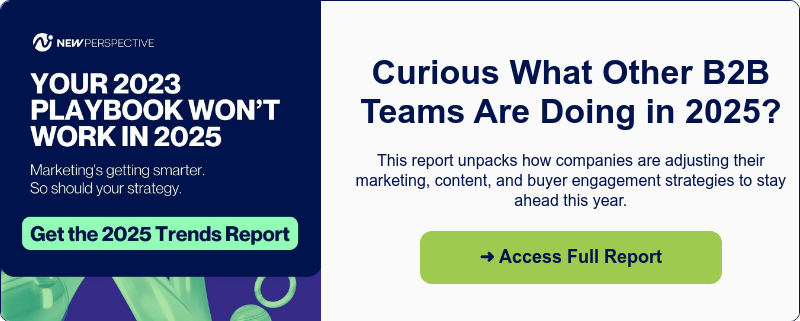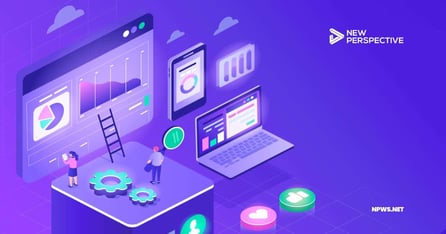21 Best B2B Lead Magnets Examples (That Aren’t eBooks)

Getting a B2B sales prospect’s attention is both an art and a science. Chosen well, B2B lead magnets are an effective tool. They provide some value for the prospect’s business, such as guidance, insights, a way to measure or calculate, a chuckle.
All that’s required to download or access is contact information. It’s a neat exchange and can be the start of a prospecting relationship that leads to a sale — once you have that contact information, you can start reaching out. But that’s only if your audience bites in the first place.
Today’s high-value prospects are not apt to give away their contact information without something good in return. The ecosystem of content and contacts perpetually cycling within the B2B realm means there’s a glut of lead magnets and a glut of low-value contacts.
Land on a website and it’s likely we’re bombarded with prompts to “Download our free eBook.” Is everyone who fills out the form to get said eBook a worthy prospect? Likely not.
To eBook or Not to eBook (or to Whitepaper or not to Whitepaper)
Creating long-format content has its place for certain industries, to be sure. Whitepapers are more narrowly focused and often packed with research and data, but they are a similar species.
What we’re finding with some of our clients is that they don’t want to put all their eggs in one basket, and they’re not always seeing great lead-generating results from their eBooks or whitepapers.
In a market of endless content and shrinking attention spans, why devote their resources to such a complicated piece of singular, static content that takes a lot of hours and care to produce, and may or may not attract people to opt-in?
One caveat here: we do have clients that swear by eBooks and we have seen (and been involved in) highly successful efforts. An eBook can convey high-concept ideas, elucidate processes and show off technologies with stellar prose and sparkly graphics.
But they’re not for everyone, they don’t work in every industry, they take a long time to read, and in some organizations all that information requires multiple phases of vetting, revising, and getting busy SMEs to weigh in. There may be another lead magnet type that’s better for your needs — less effort, more impact.
Choosing the Right B2B Lead Magnet Type: 9 Key Questions
We run things here with a Kaizen mindset: we prefer to work fast and thoroughly, and we push for optimal solutions. No one has time to waste in a high-velocity industry. Much of that has to do with creating a strong foundation of self-awareness to build on.
When a client wants to embark on a great lead generation content program, we encourage them to look into their hearts and start with some very basic questions:
First, the existential questions (I’m sure we can all relate to the last one):
- Where is our next batch of leads coming from?
- How can we get better quality leads?
- How does next quarter’s pipeline look?
- Why is prospecting so much harder than it used to be?
Then, the strategic questions:
- Who am I creating this content lead magnet for?
- What are their industry-specific pain points?
- What information can I provide to them to ease those pain points and help them better do what they do?
- What do they intend to achieve by engaging with my lead magnet?
If you can’t answer that last question, consider this: You may know what you intend to achieve, but that’s not going to generate an effective lead magnet strategy. Yes, you’re after that high-quality pipeline of leads in order to meet your ultimate goal of generating a sale.
You also want to establish trust and subject matter authority — and create a content engine that aligns with the right kind of prospects. But what do those prospects want? Do your homework and answer that question. Then you can start having fun.
Top 21 B2B Lead Magnet Ideas & Types To Help You Crush Your Lead Generation Goals
When building this list, we didn’t include just any ideas for the sake of a nice round number. We included what we believe in: viable lead magnets that aren’t eBooks. All are aimed at empowering your prospect with great information — and positioning your company as a thought leader and industry expert.
Keep this list handy and use it to strategically choose the right lead magnet for the job. With all of these, the key is great landing pages, opt-in tools, and conversion points that get you the leads you’re looking for. Whatever the medium, the objective is the same. Let’s explore what is a good lead magnet?
Live and Streaming
1. Webinars
Webinars can help cement your company’s thought leadership credentials. They’re great for offering specific subject matter expertise and giving it an attractive, dynamic, multi-layered treatment: spoken, visual, and interactive. They’re measurable — if you run interactive audience polls you can gather a whole new set of data to work with as well as the leads you generate. And they’re well-accepted as a B2B form of media.
Tips: Whether complex or simple, make sure they’re professionally produced. Focus on the subject and don’t rehash a topic that’s already been done to death. Don’t overstay your welcome: depending on industry, topic, and audience, it should last half an hour to an hour.
Bring in an industry expert or two for a more engaging discussion (which also lends credibility). Consider those audience polls, which prompt engagement. Keep them to one question each with simple, choosable answers, and share the results with the audience in real-time.
And keep promoting the webinar long after you’ve had the actual event. Streamable webinars are the gift that keeps on giving.
2. Podcasts
Some marketing mavens swear by podcasts as the new radio: for B2B, podcasts can be a lead-generating machine. Not only can you hold your audience’s attention for 30-60 minutes, but you may also get them to do it over and over again for your podcast’s multiple episodes. They’re an incredible way to boost thought leadership, reach a new audience, and get subscribers on that RSS feed — where the podcast and its episodes live.
Did you know that we have our own podcast, Green New Perspective? It’s the go-to cleantech marketing podcast for innovators and thought leaders in sustainability. With over 15,000 monthly listeners and episodes available on Spotify, YouTube, and Apple Podcasts, we explore how cutting-edge companies are scaling their solutions and navigating the challenges of a cleaner future. Check out our latest episodes for actionable insights and stories from industry leaders.
Tips: There are hundreds of hours of podcasting out there. Find a title for your series that is engaging and conveys your content and thought leadership. Stay organized and focused on a topic. Hold Q&As and panel discussions with great internal and external guests, and go for a mix of candor, stats, and expertise.
With all the tools out there, audiences expect good production. Consider what platform to syndicate on (such as Libsyn or Podbean), list the podcast on different directories (such as Google Play, iTunes, Stitcher, or Spotify) so your audience can find it on the channel of their choice, and amplify it on social media.
3. Online Events
Much of what used to unfold in hotel ballrooms and conference centers around the country has now made its way online. Business people have become far more comfortable with online meetings, seminars, and staff socials. While not the same as being there in person (and we’ve got great guidance on how to ace trade shows, virtual or not), online events and trade shows can be highly effective for engaging with prospects as part of a lead nurturing process.
Tips: Make sure you offer meaningful, relevant content that’s appropriately designed for an online event. Better to be short, sweet, and concise: long content can risk the bounce factor of having prospects leave their computers and never come back.
Tend to the technical side of your presentation, since nothing says “not worth my time” more than a session plagued with the poor transmission, bad audio, or slides that fail to load. The flip side of being more used to gathering online is that we’re a lot less forgiving of amateur hours.
4. Live Chats
Live chats are booming in popularity. They’re a great way to build a personal connection to your prospects and provide great information.
Tips: Fielding questions can be a challenge, so make sure you’re prepared. Leverage chatbot technology to engage with your customers via a personal assistant on your website and automatically qualify your leads for you.
Videos and Demos
5. Personalized Video Messages
Want to tell a story and reach out to someone directly? Video is most certainly the way of the future in terms of smart prospecting. In an era where no one seems to pick up the phone and much of the modern sales process is automated, videos are a great way to breakthrough. They show your humanity (or non-robotness) and can clarify an offer or insight as they capture someone’s attention and/or email.
Tips: Use a video messaging platform like Loom or Vidyard. Brevity is your friend: keep it under a minute or so in length if you can. Be scripted but natural. Make sure your background is optimal — this is video after all. Keep it well-lit, uncluttered, with no one walking through the frame. Be precise in your messaging and offer time for more discussion.
6. Tailored, Longer Form Videos
How-tos and case studies come to life on video — consider these mini-webinars that are meant to resonate with and engage a specific audience. You’re asking a prospect to spend time listening to your story, so be brief, entertaining, and truly informative.
Tips: Aim for 5-7 minutes in length. Emphasize key points without getting too far in the weeds. Videos should never feel like a waste of time for the audience. That said, production matters: spending budget on a pro team and an editor can pay off in far more successful lead generation. They know the latest and greatest techniques and tactics — your audience will appreciate it (and appreciation means engagement).
7. Online Product Demos
If you have targeted the right kind of prospects and your product or service is a fit, there is an opportunity to gate content of specific interest. Just think about the potential to showcase your product in the best light to an interested prospect at a time that best suits their schedule.
Tips: Take advantage of next-generation video and studio technology to show your product in action. As tempting as it might be to shoot it all on an iPhone and edit the results yourself, there is real value in getting outside professionals in to shoot and light your product in action in order to show it off to the best advantage.
Freebies and Tools
8. Calculators and Graders
Calculators and graders that measure some aspect of your business are great for getting prospects interested and engaged and motivated to take action. They can be far more effective than passive content if they’re offering something useful — and provide possible solutions as well.
Whatever they are, they should be very prospect-focused: aim at a specific industry and current need state. For instance, an ROI calculator can help your prospects calculate the ROI of using a certain product or service — thereby confirming its benefit.
Another example: our website grader that also makes recommendations on next steps to take for your website.
Tips: Make the calculator or grader stimulating and engaging — it’s a fun tool that shouldn’t be hard to use, and it should offer a clear result. Offer a great user experience and an easy way to get something even better after using it. Calculators can mine terrific information at every touchpoint, so make sure you’re grabbing data to profile your prospects too.
9. Quizzes
Another fun tool for prospects is a quiz. Create a set of questions about a specific business topic or approach — and provide a set of results depending on the answers.
It’s a great way to provide useful feedback and at the same time gather some great information. You can also use prospect responses to your quiz to further segment your target audience, providing another level of personalization and relevance in terms of what you’re providing to them.
We offer a quiz on Account-Based Marketing that provides a score as well as advice on what to do next — take a look.
Tips: The whole point is lead generation, so don’t forget that all-important landing page. Keep the quiz short and sweet so you don’t get prospects dropping off. Ours is 5 questions. But they’re good questions.
10. Surveys
Similar to one-question polls, multi-question surveys can make everyone feel like they’re part of a community and in the know — if you share the results, which you absolutely should. Your prospects want to feel like they’re smarter about their business and industry than their competitors, and surveys are certainly a great way to do it.
A well-done survey can reveal weaknesses, niches, opportunities, and trends before they’re common knowledge. And who doesn’t want to get ahead of the curve?
Tips: Use a survey to find out more about prospects’ needs and wants, or their response to a product or service, so the results are going to be useful. But don’t overload it with too many questions. Keep it short — five well-worded and clear questions can make a great impact.
Make sure the landing page gets you the information you need before they opt in, and use the responses to further segment your target audience. Then you can increase the personalization and relevance in your outreach — because you know more.
11. Business Footprint Evaluations
Our recent experience with conducting web and digital footprint analysis has been highly productive for all sides. On a cold call basis, it’s a way to demonstrate insight and relevance to a prospect who may or may not know they have a business issue to be solved. Certainly, not every prospect will convert using this method, but you’re providing real value by demonstrating your industry or technical insight.
Tips: Don’t try to make the research too deep, but do make it solid. The deep dive can happen later in the prospecting relationship. This is a way of pointing out issues/concerns about their business that you think they should be aware of. They’ll appreciate the effort you’ve expended and the relevance of the approach.
12. Real-World Evaluations
For higher-value prospects, a deeper dive analysis of a prospect’s business and industry is worth the additional time and effort. Often, an outside-in approach can uncover insights and areas for improvement that were hiding in plain sight from the prospect. This is also a great context for showing off your own perspective and expertise — giving them your insider’s take.
Tips: Consider what you can offer high-value prospects in terms of examining their business and providing them with new insights and value. Make it interesting and make it relevant.
And keep in mind that everyone wants to know where they stand compared to the rest of their market. The real value is delivered when your research can include insights and analysis on what their competition is doing.
13. Product Samples or Free Trials
Free stuff is old school, but it still works. People love a freebie: a risk-free consult, a sample of your representative product. If it gets your product or service into their hands, you have just solved the age-old challenge of getting a foot in the door.
Tips: It’s ideal if you can create a sample kit that’s highly engaging and user-friendly — we have a number of B2B clients who’ve done that with great results. Buyers love a chance to evaluate a product on their own and not feel like they’re being “sold” or having the experience micromanaged by an eager sales team. If you believe in what you are selling and want to reduce risk perception on the customer side of the equation, offer a guarantee as well. It’s always a good way to show that you stand behind the product.
14. Business and Marketing Templates
Digital business templates have become an effective and practical lead magnet. Prospects embrace a brand that truly helps solve their problems — and a template not only enables prospects to free up staff time from the odious process of creating a template themselves, it provides instant value since it can be deployed instantly. Saving a prospect the hassle and expense of having to make a tool they may not have the skillset for is also a great way to show you’re an ally.
A good example is our Manufacturing+ Marketing Bundle. It includes 10 FREE marketing and strategy templates for B2B manufacturing companies. Check it out.
Tips: Know your prospect’s business well enough to send them templates they can actually utilize. And don’t leave it up to interpretation: provide clear visual and written descriptions within the template so it’s used effectively. Your prospects must be able to understand how to use the templates to solve their problems.
15. Website Widgets
If a commercial website doesn’t have any widgets, it’s way behind the times — and that certainly goes for B2B. These built-in tools that easily integrate into your website and landing pages come in an incredible array — calendars, location maps, eye candy, spinning dials for a morsel of insider wisdom, online booking reservations, social media ads and icons, call buttons, live chats.
Tips: You really should have widgets on your website and landing pages — or you’re missing out on some very key opportunities to get leads and data, and you’re probably not going to be meeting the expectations of your prospects. We all expect widgets online, whether consciously or not: it’s just become part of online behavior.
But make sure you’re offering interesting, engaging widgets that pertain to who you are. Align them with your brand. Use them to offer a higher-value experience that’s not necessarily available to anyone. And make sure you collect valid email addresses, phone numbers, or other personal data about your prospects.
In Print
16. Case Studies
The proof is in the pudding. Case studies are a great way to share your bonafides, credentials, points of view, and “been there, done that” credibility. Nothing puts a prospect’s mind at ease quicker than a summary showing that you have worked with similar companies or parallel industries and have produced objective results in these situations.
Tips: Attend to structure, tone, and relevance. Brevity is always better so long as it’s got meaty, real details and problems prospects can relate to. One page, or a quick read, is the ideal — formatted in a structure you can repeat for more of the same: more successes equals more credibility, and a uniform format means you’re ticking off the same boxes. (Take a look at how we do it — we’ve found this structure works well for our B2B prospects.)
Consider what information your prospect wants and provide it, but don’t present yourselves as miracle workers with a problem child. Prospects don’t want a judge, they want a partner. The overarching theme: what worked and how well.
17. Blogs
We included blogs for three reasons:
- Our new clients often ask us if they need a blog the moment we start talking about content strategy
- Blogs are an often-misunderstood and often-misused way to generate leads
- Blogs don’t always generate the leads that justify the time, effort, and spend
That said, if you do have a blog, you’ll want to tend it with strategic, loving care, and make sure it’s connected to lead magnets if it’s not going to be one itself. For instance: an embedded widget, a landing page to the insider secrets-and-tricks in-depth version, a survey, a contact page.
Tips: If you do want to have a blog, you likely have your reasons. But make sure they’re the right ones and consider the audience. Don’t get into a topic your company isn’t involved in.
Don’t get on a soapbox. Do provide relevant, interesting, engaging discussion. Blogs are also not press releases — or an opportunity to slam the competition. Include objective data that doesn’t seem blatantly self-serving, and all the better if you can dish up some great insider insights.
Prospects love to be in the know — who doesn’t? Blogs should also be professionally written and carefully reviewed internally before going live. Build a first-level landing page that’s useful to you in terms of generating leads and data. Make blogs part of an overall culture of content — we’ve broken down how in 7 surprisingly easy actions in this article.
18. Email Newsletters
Subscribable newsletters can be a creative, attractive, digestible way to engage prospects and customers as well. To be candid about it, we had an interesting lesson in the power of newsletters right here. Our CEO wanted a place to reach people directly with client news, our own firm’s news, and big-picture perspective. In terms of leads, email marketing has been surprisingly effective — a growing list of email subscribers and enthusiastic calls for more.
Tips: The newsletters that engage are brief, visually appealing, and authentic. Don’t use them to throw a lot of promotional content at people. Be thoughtful, educational, and respectful. Find newsletters you like and emulate what they’re doing.
Don’t neglect SEO — for instance, all images need alt text. Hook your audience with creative subject lines. Make it as easy to unsubscribe as to subscribe. And test its effectiveness: when something doesn’t work, don’t do it anymore. When something does, do it again.
19. Cheat Sheets, Checklists, and Infographics
All that written content can and should be repurposed and into attractive, engaging one-sheets, checklists, and infographics. In this time-starved era, we can all use the Cliff Notes — and it’s a great, easy way to underscore your thought leadership and expertise.
An easy-to-follow bullet list or gorgeous chart is a great way to distill the salient points. Given that these downloaded resources are popular as instant wisdom drops, they’re a great way to get leads.
Tips: Whatever bite-sized content you’re creating, make it attractive and clear. Don’t just repeat the same exact wording as they’re based on, and do make sure there’s actionable advice.
Numbered lists are always fun. Factoids make us all feel smart. Just don’t try to tell the entire story. It’s a quick hit of information your prospects can apply to their business.
Don’t Be Shy
20. Contests
“Enter to win” may not be subtle but it’s an effective strategy to get leads into your system. The chance to win something is often irresistible — and people who would ordinarily withhold their data will readily provide it when there’s a contest. But contests shouldn’t just be a “one winner and that’s it” endeavor: they’re a fun way to engage prospects and to create a win/win relationship.
Tips: As much as possible, ensure that you are screening prospects in order to get the highest number of best fit leads into your CRM system and make sure that the perceived value of the prize is sufficient to get their attention.
Make sure that everyone is a winner at some level. Even if the prospect didn’t win the grand prize, they should still feel like they received something of value from the engagement.
21. Incentives
What’s another way to land leads? Ask your customers for introductions. Ask your employees for introductions. Incentives for helping to land great prospects are perfectly legitimate — and everyone’s doing it.
Tips: Don’t be shy about incentivizing customers or employees. Don’t wait for them to come to you with offers of an introduction either. Be clear about this: reach out to them, tell them why their referral is of value to you, and let them know what you plan to do for them in return. And, of course, do it.
B2B Lead Magnets are All About Leads
Whatever kind of B2B lead magnet you want to try, always consider your specific target audience — their industry, their pain points, their priorities. Create material that is relevant, engaging, and valuable.
This isn’t about selling. It’s not about a single transaction. It’s about building an ongoing business relationship. The tone and quality of the material you share with prospects will go a long way to laying the groundwork for a great partnership.
New Perspective is currently running a business development campaign that provides prospects with insights on their web presence and digital footprint — it gives them the wisdom they need to know; content that has value; analysis that they otherwise wouldn’t have.
That’s the kind of effort that helps to cement our thought leadership position. And it’s led to 2x open rates on emails — which we see as a vital first step in creating new business relationships.
We have extensive experience with all of these lead magnets — and we’d love to help you find the ones that suit your needs. If you’re in the market for some great guidance on your business and industry, get in touch with us.




